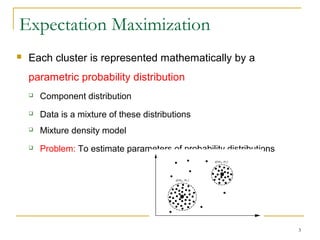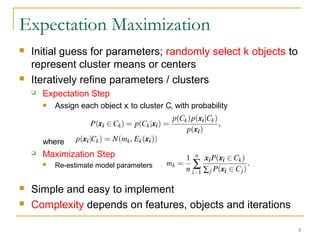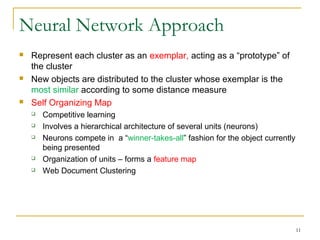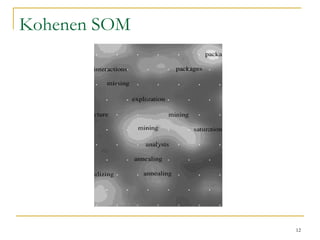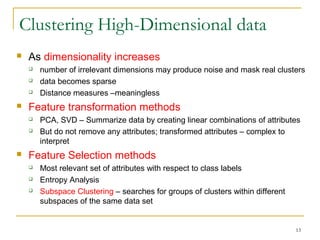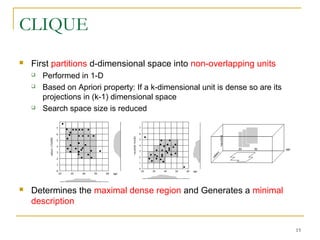3.5 model based clustering
- 1. Clustering Model based techniques and Handling high dimensional data 1
- 2. 2 Model-Based Clustering Methods Attempt to optimize the fit between the data and some mathematical model Assumption: Data are generated by a mixture of underlying probability distributions Techniques Expectation-Maximization Conceptual Clustering Neural Networks Approach
- 3. Expectation Maximization Each cluster is represented mathematically by a parametric probability distribution Component distribution Data is a mixture of these distributions Mixture density model Problem: To estimate parameters of probability distributions 3
- 4. Expectation Maximization Iterative Refinement Algorithm – used to find parameter estimates Extension of k-means Assigns an object to a cluster according to a weight representing probability of membership Initial estimate of parameters Iteratively reassigns scores 4
- 5. Expectation Maximization Initial guess for parameters; randomly select k objects to represent cluster means or centers Iteratively refine parameters / clusters Expectation Step Assign each object xi to cluster Ck with probability where Maximization Step Re-estimate model parameters Simple and easy to implement Complexity depends on features, objects and iterations 5
- 6. 6 Conceptual Clustering Conceptual clustering A form of clustering in machine learning Produces a classification scheme for a set of unlabeled objects Finds characteristic description for each concept (class) COBWEB A popular and simple method of incremental conceptual learning Creates a hierarchical clustering in the form of a classification tree Each node refers to a concept and contains a probabilistic description of that concept
- 7. 7 COBWEB Clustering Method A classification tree
- 8. COBWEB Classification tree Each node – Concept and its probabilistic distribution (Summary of objects under that node) Description – Conditional probabilities P(Ai=vij / Ck) Sibling nodes at given level form a partition Category Utility Increase in the expected number of attribute values that can be correctly guessed given a partition 8
- 9. COBWEB Category Utility rewards: Intra-class similarity P(Ai=vij|Ck) High value indicates many class members share this attribute-value pair Inter-class dissimilarity P(Ck|Ai=vij) High values – fewer objects in different classes share this attribute- value Placement of new objects Descend tree Identify best host Temporarily place object in each node and compute CU of resulting partition Placement with highest CU is chosen COBWEB may also forms new nodes if object does not fit into the existing tree 9
- 10. COBWEB COBWEB is sensitive to order of records Additional operations Merging and Splitting Two best hosts are considered for merging Best host is considered for splitting Limitations The assumption that the attributes are independent of each other is often too strong because correlation may exist Not suitable for clustering large database data CLASSIT - an extension of COBWEB for incremental clustering of continuous data 10
- 11. Neural Network Approach Represent each cluster as an exemplar, acting as a “prototype” of the cluster New objects are distributed to the cluster whose exemplar is the most similar according to some distance measure Self Organizing Map Competitive learning Involves a hierarchical architecture of several units (neurons) Neurons compete in a “winner-takes-all” fashion for the object currently being presented Organization of units – forms a feature map Web Document Clustering 11
- 12. Kohenen SOM 12
- 13. Clustering High-Dimensional data As dimensionality increases number of irrelevant dimensions may produce noise and mask real clusters data becomes sparse Distance measures –meaningless Feature transformation methods PCA, SVD – Summarize data by creating linear combinations of attributes But do not remove any attributes; transformed attributes – complex to interpret Feature Selection methods Most relevant set of attributes with respect to class labels Entropy Analysis Subspace Clustering – searches for groups of clusters within different subspaces of the same data set 13
- 14. CLIQUE: CLustering In QUest Dimension growth subspace clustering Starts at 1-D and grows upwards to higher dimensions Partitions each dimension – grids – determines whether cell is dense CLIQUE Determines sparse and crowded units Dense unit – fraction of data points > threshold Cluster – maximal set of connected dense units 14
- 15. CLIQUE First partitions d-dimensional space into non-overlapping units Performed in 1-D Based on Apriori property: If a k-dimensional unit is dense so are its projections in (k-1) dimensional space Search space size is reduced Determines the maximal dense region and Generates a minimal description 15
- 16. CLIQUE Finds subspace of highest dimension Insensitive to order of inputs Performance depends on grid size and density threshold Difficult to determine across all dimensions Several lower dimensional subspaces will have to be processed Can use adaptive strategy 16
- 17. PROCLUS – PROjected CLUStering Dimension-reduction Subspace Clustering technique Finds initial approximation of clusters in high dimensional space Avoids generation of large number of overlapped clusters of lower dimensionality Finds best set of medoids by hill-climbing process (Similar to CLARANS) Manhattan Segmental distance measure 17
- 18. PROCLUS Initialization phase Greedy algorithm to select a set of initial medoids that are far apart Iteration Phase Selects a random set of k-medoids Replaces bad medoids For each medoid a set of dimensions is chosen whose average distances are small Refinement Phase Computes new dimensions for each medoid based on clusters found, reasigns points to medoids and removes outliers 18
- 19. Frequent Pattern based Clustering Frequent patterns may also form clusters Instead of growing clusters dimension by dimension sets of frequent itemsets are determined Two common technqiues Frequent term-based text Clustering Clustering by Pattern similarity 19
- 20. Frequent-term based text clustering Text documents are clustered based on frequent terms they contain Documents – terms Dimensionality is very high Frequent term based analysis Well selected subset of set of all frequent terms must be discovered Fi – Set of frequent term sets Cov(Fi) – set of documents covered by Fi ∑i=1 k cov(Fi) = D and overlap between Fi and Fj must be minimized Description of clusters – their frequent term sets 20
- 21. Clustering by Pattern Similarity pCluster on micro-array data analysis DNA micro-array analysis – expression levels of two genes may rise and fall synchronously in response to stimuli Two objects are similar if they exhibit a coherent pattern on a subset of dimensions 21
- 22. pCluster Shift Pattern discovery Euclidean distance – not suitable Derive new attributes Bi-Clustering based on mean squared residue score pCluster Objects –x, y; attributes – a, b A pair (O,T) forms a δ-pCluster if for any 2 x 2 matrix X in (O, T) pScore(X) <= δ Each pair of objects and their features must satisfy threshold 22
- 23. pCluster Scaling patterns pCluster can be used in other applications also 23


